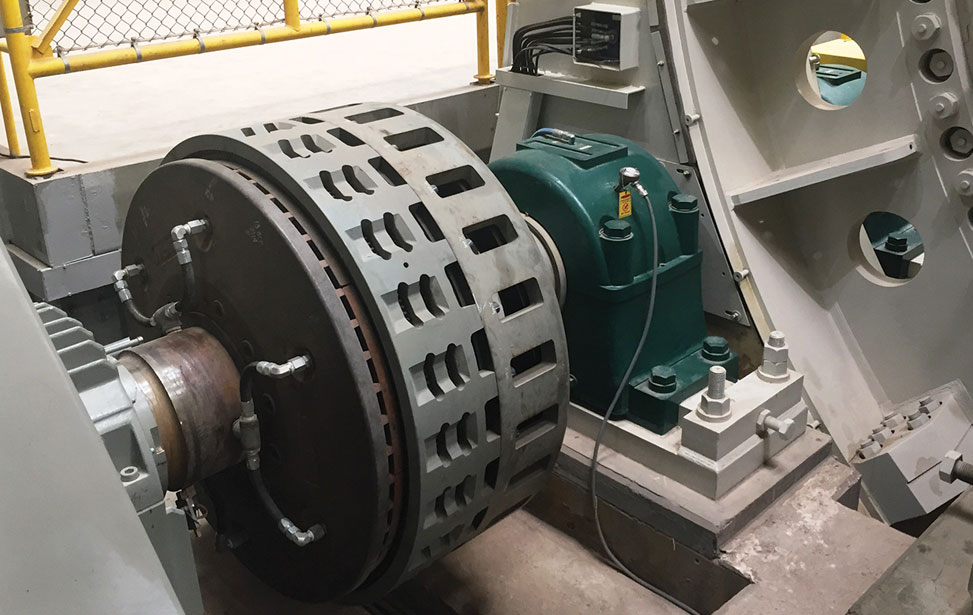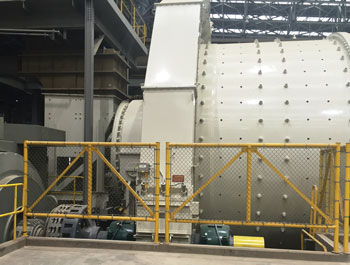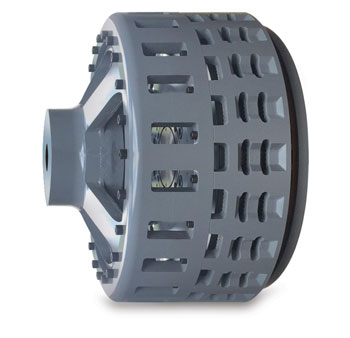Smooth Operators: Wichita multi-plate clutch technology

A Model 360 Grinding Mill Clutch (GMC) with 60 in. diameter friction discs installed on a ball mill at one of the world’s largest (and oldest) open pit copper mines in Mexico.
Smooth Operators: Wichita multi-plate clutch technology smooths out damaging torque spikes during grinding mill start-up
By Richard MayberryWichita Clutch Product Manager
On geared ball and SAG mills with large inertia loads, multi-plate clutches are often utilized to provide smooth torque ramp-up to the mill’s pinion gear speed while keeping the power spike down on the motor current draw as the mill starts to rotate.
After mill-to-motor speed synchronization, multi-plate clutches can also provide a level of protection during torque overload conditions in the mill by slipping if an unforeseen load spike occurs. This slippage protects the mill’s pinion gear, ring gear and gearbox (if installed), which are all expensive items with typically long lead times.
Some mills install drum style clutch units. However, multi-plate clutches have greater swept areas for the metal center plates as compared to drum clutches, allowing better heat absorption. Another disadvantage of drum clutches is that when they spin up to speed, their torque value can drop off due to centrifugal force.
Multi-plate friction disc clutches utilize a very compact shape factor to provide a high level of torque. In grinding mill applications, compact multi-plate clutches can be sized based on diameter and clutch assembly length, a real advantage compared to drum style units.

Multi-plate clutches are often utilized to provide smooth torque ramp-up on geared ball and SAG mills with large inertia loads.
Smaller-sized mill operators sometimes use fluid couplings and a mechanical lock-up feature for smooth startups. But these types of solutions are horsepower-limited in their ability.
The clutches are used on geared mills only because of the position of the mill drive motor. Gearless motor configurations don’t require a clutch because the motor is built into the frame of the mill.
Multi-plate, shaft-to-shaft clutches are typically installed as close to the pinion shaft as possible to provide the greatest level of protection of the driveline components during an overload condition. The two main driveline configurations are:
- Low-speed motor > clutch > pinion
- High-speed motor > gear reducer > clutch > pinion
Due to their respective functionality, ball and SAG mills each have different torque overload requirements. For example, the torque overload capacity requirement for a ball mill is 200%. A SAG mill requirement might be 225-250% torque based on Full Load Motor Torque (FLMT). This is the amount of torque the drive motor can produce on a temporary basis during start up.
Wichita Clutch has designed its multi-plate Grinding Mill Clutch (GMC) specifically for use on challenging ball and SAG mill applications.
As previously mentioned, heat dissipation is very important during and after a mill start up from a stationary position. This is when the most energy is created during the slipping of the clutch to bring the mill speed up to match the motor speed. High levels of heat are also generated during mill jogging and inching operations.
All this energy is dissipated in two areas, the friction material and the thermal mass of the mating metal rotors or center plates.
The friction material-to-center plate interface area is where this energy is created during the clutch slipping at start-up. Temperatures can be as high as 600°F and the slip time can run as long as 10 seconds, but normally 3-6 seconds. The thermal energy is stored in the metal center plates as heat rises in these plates.

Wichita Clutch GMC unit shown with optional Quick-Change Adapter that allows the drive ring to be moved away from the clutch, enabling friction disc replacement without the need to disassemble the clutch completely.
Wichita Clutch has developed a unique high-coefficient of friction material specially-suited for GMC applications. Its blending of semi-metallic, organic and high temperature phenolic resin binders makes it the ideal choice for GMC units. The material is heat fade-resistant and is made to provide long friction disc life if used within normal limits. In service for many years, this robust friction material installed in GMC units continues to provide customers with a solution that can withstand heavy-duty mill startups on a repetitive basis.
The GMC incorporates an annular-shaped air tube which is constructed from reinforced neoprene rubber in a vulcanized fabrication. This makes for an easily changed unitized part as compared to a metal piston and O-ring seals. It also provides a very responsive way to create force to compress the friction discs against the metal rotors or center plates to transmit torque from the motor, through the clutch, to the mill. This force creation is very repeatable and has an extremely low hysteresis as compared to a piston-style actuator.
The air control system requirement for a GMC unit installed on single pinion drive mill is fairly basic and can be accommodated with standard-size airtube pressure ports. However, dual-pinion drives require a more robust air control system with much larger air tube pressure ports to provide a very responsive torque ramp-up for the mill drive.
Most larger GMC models are shipped with the optional Quick-Change Adapter that features a set of parts that allows the drive ring, on the outside of the clutch, to be more easily moved back away from the clutch. This allows access for friction disc replacement without having to disassemble the clutch completely. This development was driven by growing operator desire to reduce clutch maintenance man-hours associated with disc replacement in the field.
Wichita also offers friction discs that are split into two 180-degree segments to assist in helping customers replace worn friction discs. This eliminates having to completely disassemble the clutch unit for disc replacements, saving many man-hours of work.
Wichita GMC units offer more torque in a smaller package for a less expensive overall install and long life if properly used and maintained.
Case Studies
Wichita GMC provides smooth starts on a Mexican copper mine ball mill
Wichita Clutch supplied a Model 360 Grinding Mill Clutch (GMC) with 60 in. diameter friction discs and a torque rating of 11,870,250 in.lbs. (1,341,158 Nm) for a ball mill at one of the world’s largest (and oldest) open pit copper mines located in Mexico.
The clutch’s primary role on the dual-pinion, direct-drive geared mill is to provide smooth starts during mill startup. When the mill is running, the clutch also serves as a torque “circuit breaker,” reducing costly repairs and downtime by protecting the pinions and ring gear from potential damage caused by large pieces of grinding material.
The unit shipped with a quick-change adapter that enables replacement of any wearing clutch part without disturbing either shaft.
The GMC airtube design combines all the best features of a disc type clutch with all the advantages of direct air engagement. It is the simplest and most trouble-free method of applying air pressure yet designed.
Chinese open pit copper mine SAG mill utilizes a Wichita GMC
A Model 336H Grinding Mill Clutch (GMC) with 36 in. diameter friction discs and a torque rating of 2,134,650 in.lbs. (241,183 Nm) was supplied to a leading global grinding mill OEM. The clutch was installed on geared SAG mill at one of China’s largest open pit copper mines.
Wichita air-applied GMCs are specially designed to provide quick, smooth starts with limited current surge on geared grinding mills with large inertia loads.
The clutch is adaptable to remote control allowing centralized operation through simple air or electric circuits.
Download a PDF of this article